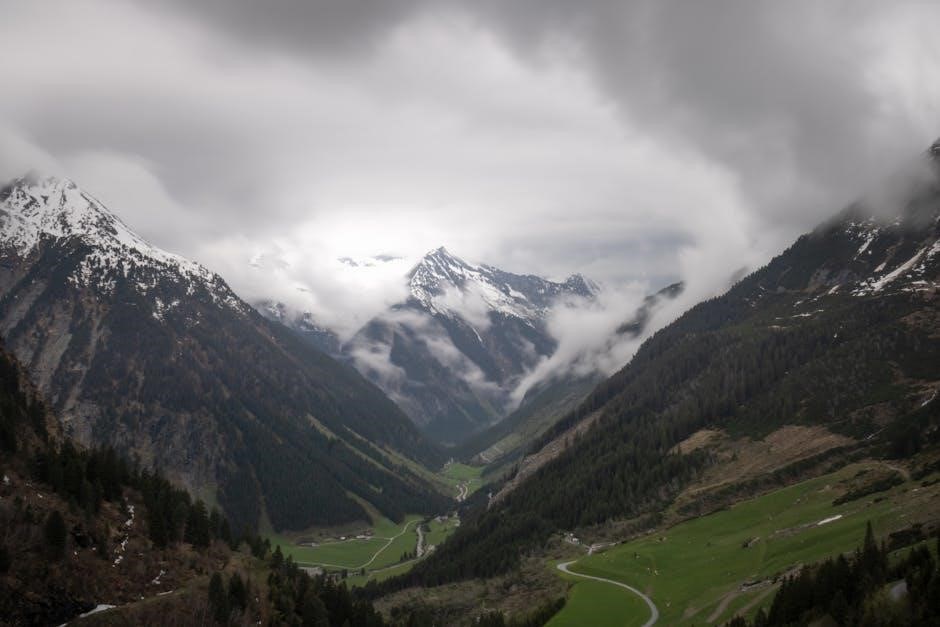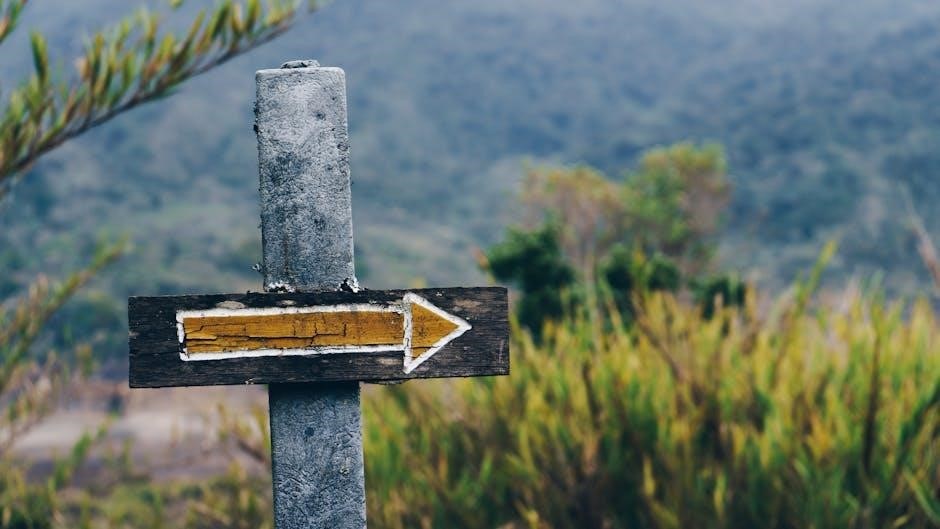This section introduces the Population Growth Worksheet PDF, designed to help students understand key concepts like exponential and logistic growth models, carrying capacity, and their practical applications․ It provides a structured approach to learning population dynamics, enabling students to analyze growth trends, calculate rates, and interpret data effectively․ The worksheet includes exercises and questions to reinforce theoretical knowledge, making it an essential tool for interactive learning and assessment․ The answer key offers detailed solutions, helping students verify their understanding and identify areas for improvement․ Whether for classroom use or self-study, this resource is a comprehensive guide to mastering population growth principles․
1․1 What is a Population Growth Worksheet?
A Population Growth Worksheet is an educational tool designed to help students explore and understand the dynamics of population growth․ It typically includes structured exercises, graphs, and data analysis tasks that focus on key concepts such as exponential and logistic growth models, carrying capacity, and environmental resistance․ The worksheet often provides real-world data or hypothetical scenarios for students to calculate growth rates, interpret trends, and predict future population sizes․ By engaging with these activities, students develop practical skills in applying mathematical formulas and ecological principles to population studies․ The worksheet is complemented by an answer key, which offers solutions and explanations to guide learning and assessment․

1․2 Importance of Using Worksheets for Learning Population Growth

Using worksheets for learning population growth is highly beneficial for students as it provides a hands-on approach to understanding complex concepts․ Worksheets offer structured exercises that allow students to apply theoretical knowledge to real-world scenarios, such as calculating growth rates or analyzing graphs․ They also encourage active learning by engaging students in problem-solving and data interpretation․ Additionally, worksheets with answer keys enable self-assessment, helping students identify their strengths and areas needing improvement․ Regular practice through worksheets enhances conceptual clarity and reinforces understanding of key principles like exponential and logistic growth models․ This interactive method makes learning population dynamics more accessible and effective, preparing students for advanced studies or practical applications in ecology and demographics․

1․3 Structure of the Population Growth Worksheet PDF
The Population Growth Worksheet PDF is organized into clear sections to facilitate systematic learning․ It begins with introductory questions about population growth basics, followed by sections dedicated to key concepts such as exponential and logistic growth models․ The worksheet includes multiple-choice questions, short-answer prompts, and graphical analyses to test understanding․ Practical exercises, like calculating population growth rates and interpreting data, are also incorporated․ A dedicated section focuses on case studies, allowing students to apply theoretical knowledge to real-world scenarios․ The PDF concludes with an answer key, providing detailed solutions and explanations to help students verify their work․ This structured approach ensures comprehensive coverage of population growth principles, making it an invaluable resource for learners․
Key Concepts of Population Growth
This section explores fundamental concepts, including exponential and logistic growth models, carrying capacity, and factors influencing population dynamics․ It provides a foundation for understanding birth and death rates, environmental resistance, and resource availability impacts on population trends, essential for analyzing growth patterns in various ecosystems and regions․
2․1 Exponential Growth Model
The exponential growth model describes rapid population increase under ideal conditions with unlimited resources․ It follows the formula ( N(t) = N_0 e^{rt} ), where ( N(t) ) is the population size at time ( t ), ( N_0 ) is the initial population, ( r ) is the growth rate, and ( t ) is time․ This model assumes no environmental limits, leading to a J-shaped growth curve․ However, in reality, exponential growth is unsustainable due to resource constraints and environmental resistance, eventually transitioning to logistic growth․ Examples include bacteria in a nutrient-rich medium or deer populations in a predator-free area․ This model highlights the importance of understanding growth patterns in ecosystems and resource management․ Real-world applications often involve analyzing how populations adapt when resources become limited, emphasizing the model’s theoretical significance․
2․2 Logistic Growth Model
The logistic growth model describes population growth where resources are limited, leading to a slowdown as the population approaches its carrying capacity․ The formula is ( N(t) = K / (1 + (K/N_0)e^{-rt} ) ), where ( K ) is the carrying capacity, ( N_0 ) is the initial population, ( r ) is the growth rate, and ( t ) is time․ This model results in an S-shaped growth curve, with rapid growth initially, followed by stabilization as environmental resistance increases․ It is more realistic than exponential growth, as it accounts for resource limitations․ Examples include animal populations in ecosystems with finite food and space․ Understanding this model is crucial for managing natural resources and predicting long-term population trends in diverse environments․
2․3 Carrying Capacity and Its Role in Population Growth
Carrying capacity (K) refers to the maximum population size an environment can sustain indefinitely, determined by resource availability, space, and environmental resistance․ It plays a central role in population growth models, particularly the logistic model, where growth slows as the population approaches K․ When a population exceeds carrying capacity, it often leads to resource depletion, increased competition, and reduced survival rates․ Understanding carrying capacity is essential for managing ecosystems, predicting population trends, and developing conservation strategies․ For example, wildlife managers use carrying capacity to determine sustainable hunting quotas or habitat restoration efforts․ It ensures populations remain balanced with their environment, maintaining ecological stability and biodiversity over time․

Factors Influencing Population Growth
Population growth is influenced by natural factors like birth and death rates, human activities such as resource exploitation, and environmental resistance, shaping ecosystem dynamics and stability․
3․1 Natural Factors: Birth and Death Rates
Natural factors, such as birth and death rates, play a crucial role in shaping population growth․ Birth rates contribute to an increase in population size, while death rates act as a counterbalance․ These rates are influenced by various ecological conditions, including food availability, disease prevalence, and environmental quality․ In exponential growth models, birth rates often exceed death rates, leading to rapid population expansion․ However, as populations approach their carrying capacity, death rates may rise due to increased competition for resources, aligning more closely with logistic growth patterns․ Understanding these natural factors is essential for accurately modeling and predicting population dynamics, as highlighted in the worksheet․
3․2 Human Activities and Their Impact on Population Growth
Human activities significantly influence population growth, often altering natural trends․ Technological advancements, urbanization, and resource exploitation can increase birth rates by improving healthcare and living standards․ Conversely, environmental degradation and resource depletion can lead to higher death rates or reduced fertility․ Migration patterns, driven by economic or political factors, also redistribute populations, affecting regional growth rates․ Additionally, human-induced climate change and habitat destruction can disrupt ecosystems, indirectly impacting population dynamics․ Understanding these interactions is crucial for predicting future trends and managing sustainable development․ The worksheet explores these complexities, offering insights into how human actions shape population growth patterns globally and regionally․
3․3 Environmental Resistance and Its Effects
Environmental resistance refers to the collective factors that limit population growth, ensuring it does not exceed the ecosystem’s carrying capacity․ These factors include resource availability, predators, climate, and disease․ As populations grow, environmental resistance increases, slowing growth rates․ For instance, limited food supply forces competition, reducing birth rates or increasing mortality․ Predators and diseases further constrain population size by targeting vulnerable individuals․ The worksheet explores how these elements interact, illustrating their role in maintaining ecological balance․ Understanding environmental resistance is vital for predicting population trends and managing ecosystems sustainably․ Through practical exercises, students analyze how these factors influence growth patterns, preparing them to address real-world ecological challenges effectively․

Applications of Population Growth Models
Population growth models are essential for predicting future trends, managing resources, and conservation planning․ They aid in understanding the impact of resource availability on ecosystems and human activities․
4․1 Predicting Future Population Trends
Population growth models are widely used to predict future population trends, enabling better planning and resource management․ By analyzing historical data and applying exponential or logistic growth models, scientists can forecast population sizes․ These predictions help identify potential challenges, such as resource scarcity or environmental strain․ For instance, the exponential growth model shows rapid increases, while the logistic model accounts for carrying capacity limits․ Understanding these trends is crucial for policymakers to prepare for future demands․ Additionally, these models help assess the impact of factors like birth rates, death rates, and migration․ Accurate predictions enable proactive measures, such as infrastructure development or conservation strategies, ensuring sustainable growth and resource allocation․
4․2 Understanding the Impact of Resource Availability
Resource availability plays a critical role in shaping population growth dynamics․ Limited resources, such as food, water, and habitat, act as constraints, influencing growth rates and population size․ As resources become scarce, competition increases, slowing growth and potentially leading to population decline․ Conversely, abundant resources can support rapid growth, often following an exponential pattern․ The logistic growth model highlights this relationship, showing how populations stabilize as they approach carrying capacity․ Understanding these interactions helps in managing ecosystems and predicting how resource changes, such as climate shifts or human activities, will impact populations․ This knowledge is essential for conservation efforts and sustainable resource management, ensuring balanced ecosystems and long-term population health․
4․3 Managing Wildlife and Ecosystems
Effective management of wildlife and ecosystems relies heavily on understanding population growth patterns․ By analyzing growth models, conservationists can predict population trends and implement strategies to maintain ecological balance․ For instance, identifying carrying capacity helps set sustainable hunting limits or habitat restoration goals․ Resource availability and environmental resistance are crucial factors in these decisions․ Wildlife managers use population data to develop policies that prevent overexploitation and protect endangered species․ Additionally, understanding exponential and logistic growth aids in controlling invasive species and restoring declining populations․ These insights ensure that ecosystems remain resilient, supporting biodiversity and ecological health for future generations․ Practical exercises in worksheets help refine these skills, making them indispensable tools for wildlife and ecosystem management․

Regional Trends in Population Growth
This section explores regional population trends, noting rapid growth in developing countries and slower or negative growth in developed nations, influenced by urbanization and access to resources․
5․1 Population Growth in Developing Countries
Population growth in developing countries is often rapid due to high birth rates and declining mortality rates․ Urbanization and improved healthcare contribute to this trend, while limited access to education and family planning resources can sustain high growth rates․ Economic challenges, such as poverty and resource scarcity, often accompany rapid population growth, straining infrastructure and services․ However, some regions are experiencing a demographic shift as education levels rise and contraceptive use increases, leading to slower growth rates․ Understanding these dynamics is crucial for addressing developmental challenges and ensuring sustainable growth in these regions․
5․2 Population Growth in Developed Countries
Population growth in developed countries is generally slower compared to developing nations, often due to lower birth rates and aging populations․ Factors such as increased life expectancy and access to advanced healthcare contribute to these trends․ In some regions, like Russia and Eastern Europe, populations are even declining․ Immigration plays a role in stabilizing population numbers in certain areas, such as the Frostbelt regions, where new opportunities attract residents․ Understanding these dynamics is essential for addressing challenges like labor shortages and resource allocation․ These trends highlight the need for policies that support sustainable development and economic stability in developed countries․
5․3 Case Studies of Rapid Population Growth
Case studies reveal regions experiencing rapid population growth due to favorable conditions․ Areas like the Frostbelt, where new opportunities attract residents, show resurgence in growth․ Rapid growth often stems from high birth rates, immigration, and economic prosperity․ For instance, regions with abundant resources or emerging industries tend to attract settlers, leading to population surges․ However, such growth strains local infrastructure and ecosystems․ These studies highlight the importance of understanding growth drivers and managing resources sustainably․ Analyzing these cases provides insights into balancing development with environmental and social stability, offering lessons for future planning and policy implementation to mitigate challenges posed by rapid population expansion․

Practical Exercises in the Worksheet
This section provides practical exercises, including calculating growth rates, analyzing population graphs, and solving carrying capacity problems․ The answer key helps verify solutions and deepen understanding․
6․1 Calculating Population Growth Rate
Calculating population growth rate involves understanding the formula: dN/dt = birth rate ⎻ death rate + immigration rate ⎻ emigration rate․ This exercise helps students apply mathematical concepts to real-world population dynamics․ The worksheet provides data on birth and death rates, allowing learners to compute growth rates manually․ It also introduces the concept of carrying capacity and how environmental factors influence growth․ Practical problems include estimating future population sizes based on current trends․ The answer key offers step-by-step solutions, ensuring students grasp the methodology․ This exercise bridges theory and application, enabling learners to analyze and predict population changes accurately․ It is a foundational skill for understanding ecological and demographic processes․
6․2 Analyzing Graphs of Population Growth
Analyzing graphs of population growth helps students visualize trends and understand growth patterns over time․ The worksheet includes exponential and logistic growth curves, allowing learners to identify key features like the J-shaped and S-shaped curves․ Exercises involve interpreting graphs to determine growth rates, carrying capacity, and environmental resistance․ Students learn to distinguish between rapid growth phases and stabilization periods․ The answer key provides annotated examples, highlighting common mistakes and offering insights into accurate interpretation․ This section enhances data interpretation skills and connects theoretical models to real-world population dynamics․ By analyzing graphs, students gain a deeper understanding of how populations respond to environmental and demographic changes․ This skill is essential for predicting future trends and managing ecosystems effectively․
6․3 Solving Problems Related to Carrying Capacity
Solving problems related to carrying capacity involves understanding how populations interact with their environment and resource limits․ The worksheet provides exercises where students calculate carrying capacity (K) using population growth formulas and interpret results․ Key questions focus on identifying factors that influence K, such as resource availability and environmental resistance․ Students learn to apply the formula ( K = rac{ ext{birth rate} ⎼ ext{death rate}}{ ext{environmental resistance}} ) to estimate maximum population size․ Practical problems also include analyzing how human activities or environmental changes affect K․ The answer key offers step-by-step solutions, explaining how to interpret calculations and relate them to real-world scenarios․ This section enhances problem-solving skills and deepens understanding of population-environment dynamics, preparing students to address ecological challenges effectively․
Answer Key Sections
The answer key provides detailed solutions to worksheet questions, ensuring accuracy and understanding․ It includes step-by-step explanations, guidance on common mistakes, and tips for deeper comprehension of population growth concepts․
7․1 How to Use the Answer Key Effectively
To use the answer key effectively, start by completing the worksheet independently․ Compare your answers with the key to identify strengths and areas for improvement․ Pay attention to step-by-step solutions for complex questions, as they provide clarity on problem-solving methods․ Highlight or underline sections where you made mistakes to review later․ Use the key to understand common errors and avoid repeating them in future assignments․ For interpretative questions, focus on how the answers align with population growth concepts like exponential or logistic models․ Regularly reviewing the answer key helps reinforce learning and ensures a deeper understanding of the material․ This approach maximizes the educational value of the worksheet and enhances retention of key concepts․
7․2 Common Mistakes to Avoid
When working with the population growth worksheet, common mistakes include confusing exponential and logistic growth models, miscalculating growth rates, and misinterpreting carrying capacity․ Students often overlook environmental resistance factors or misunderstand demographic transitions․ Errors in graph analysis, such as mislabeling axes or misidentifying trends, are frequent․ Additionally, some may fail to consider the impact of human activities on population dynamics․ To avoid these mistakes, carefully review formulas, ensure accurate data interpretation, and pay attention to conceptual distinctions; Regular practice and cross-referencing with the answer key can help mitigate these errors and improve overall understanding․ Awareness of these pitfalls enhances the learning experience and ensures accurate problem-solving․
7․3 Interpreting Results for Deeper Understanding
Interpreting results in the population growth worksheet helps students gain insights into population dynamics and real-world implications․ By analyzing calculated growth rates and comparing them to theoretical models, learners can better understand how environmental factors influence population trends․ For instance, identifying whether a population follows an exponential or logistic growth pattern reveals the role of carrying capacity and resource limitations․ Additionally, interpreting graphs and data trends enables students to predict future population changes and assess the impact of human activities․ This process fosters critical thinking and connects abstract concepts to practical applications, such as conservation planning or resource management․ Accurate interpretation also enhances the ability to address complex ecological challenges effectively․

Additional Resources for Further Learning
This section offers supplementary materials, including recommended readings, online tools, and additional worksheets, to deepen understanding and practical application of population growth concepts effectively․

8․1 Recommended Reading Materials
Supplement your learning with textbooks, research papers, and online guides that delve into population growth dynamics․ Key materials include Population Ecology chapters, which explain density, dispersion, and demographics․ Human Population Growth graphs and case studies provide real-world insights․ Additionally, resources like Nutrient Cycles POGIL and Mitosis-labeling exercises offer practical applications․ For advanced understanding, explore Technology and Vocational Training impacts on population trends․ These materials are available in PDF formats and online platforms, ensuring accessible learning․ They cover exponential and logistic growth, carrying capacity, and regional population trends, aiding in a comprehensive grasp of the subject․ Use these resources to deepen your knowledge and apply concepts effectively in assignments and discussions․
8․2 Online Tools for Population Growth Analysis
Enhance your understanding of population dynamics with online tools designed for interactive learning․ Platforms like SBI3U Dichotomous Keys Gizmo offer simulations to explore exponential and logistic growth models․ Population Growth Worksheet & Answer Key by Da Learning Dojo provides downloadable resources for practical exercises․ Additionally, Nutrient Cycles POGIL and Mitosis-labeling tools introduce concepts through engaging activities․ These tools allow students to calculate growth rates, analyze graphs, and solve problems related to carrying capacity․ They also include data visualization features to explore regional trends and case studies․ Utilizing these resources enhances critical thinking and problem-solving skills, making complex concepts more accessible and interactive for learners of all levels․
8․3 Supplementary Worksheets and Quizzes
Supplement your learning with additional worksheets and quizzes designed to reinforce population growth concepts․ Resources like Population Growth Worksheet & Answer Key by Da Learning Dojo offer comprehensive exercises covering exponential and logistic growth models, carrying capacity, and regional trends․ SBI3U Dichotomous Keys Gizmo and Nutrient Cycles POGIL provide interactive simulations to explore population dynamics․ These tools include quizzes to test understanding, with answer keys for self-assessment․ They also feature case studies, such as the decline of native red squirrels, to apply theoretical knowledge․ Supplementary materials cater to diverse learning styles, ensuring a well-rounded understanding of population growth principles and their real-world applications․




















